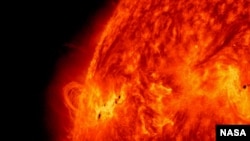Our sun is a stormy place with frequent flares, but according to new research, we may have yet to see just how violent a star like the sun could be.
Writing in The Astrophysical Journal Letters, researchers at the University of Warwick say they’ve observed a “superflare” on a distant binary star in the Milky Way galaxy.
Superflares, researchers say, are thousands of times more powerful than what we have come to know as "standard” solar flares.
Those enormous bursts of energy leaping out millions of kilometers from the sun’s surface have affected electronics equipment and communications on Earth on many occasions.
'Billion-megaton bomb'
“Typical solar flares can have energies equivalent to 100-million-megaton bombs, but a superflare on the sun could release energy equivalent to a billion-megaton bomb,” the researchers said in a news release.
A superflare in our solar system would wreak havoc on Earth, or worse, according to Chloë Pugh at the British university's Center for Fusion, Space and Astrophysics.
Fortunately, she added, observations throughout history of our sun’s activity indicate such a development is extremely unlikely.
“Stars very similar to the sun have been observed to produce enormous flares, called superflares,” according to lead researcher on the University of Warwick’s team. “To give us a better indication of whether the sun could produce a catastrophic superflare, we need to determine whether the same physical processes are responsible for both stellar superflares and solar flares.”
Space telescope
Using data collected by NASA’s Kepler space telescope, the researchers determined that the far-off star that was observed emitting a superflare – a binary star system known as KIC9655129 – had wave properties identical to those seen in flares produced by Earth’s sun.
Anne-Marie Broomhall, a co-author of the newly published study, paper said the same physical processes are involved in both cases, so that finding “supports the hypothesis that the sun is able to produce a potentially devastating superflare."
"If the Sun were to produce a superflare it would be disastrous for life on Earth,” Pugh said. “Our GPS and radio communication systems could be severely disrupted and there could be large-scale power blackouts as a result of strong electrical currents being induced in power grids. Fortunately the conditions needed for a superflare are extremely unlikely to occur on the sun, based on previous observations of solar activity."









